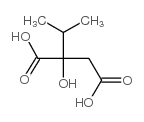The role of glutamate 87 in the kinetic mechanism of Thermus thermophilus isopropylmalate dehydrogenase.
A M Dean, L Dvorak
文献索引:Protein Sci. 4(10) , 2156-67, (1995)
全文:HTML全文
摘要
The kinetic mechanism of the oxidative decarboxylation of 2R,3S-isopropylmalate by the NAD-dependent isopropylmalate dehydrogenase of Thermus thermophilus was investigated. Initial rate results typical of random or steady-state ordered sequential mechanisms are obtained for both the wild-type and two mutant enzymes (E87G and E87Q) regardless of whether natural or alternative substrates (2R-malate, 2R,3S-tartrate and/or NADP) are utilized. Initial rate data fail to converge on a rapid equilibrium-ordered pattern despite marked reductions in specificity (kcat/Km) caused by the mutations and alternative substrates. Although the inhibition studies alone might suggest an ordered kinetic mechanism with cofactor binding first, a detailed analysis reveals that the expected noncompetitive patterns appear uncompetitive because the dissociation constants from the ternary complexes are far smaller than those from the binary complexes. Equilibrium fluorescence studies both confirm the random binding of substrates and the kinetic estimates of the dissociation constants of the substrates from the binary complexes. The latter are not distributed markedly by the mutations at site 87. Mutations at site 87 do not affect the dissociation constants from the binary complexes, but do greatly increase the Michaelis constants, indicating that E87 helps stabilize the Michaelis complex of the wild-type enzyme. The available structural data, the patterns of the kinetics results, and the structure of a pseudo-Michaelis complex of the homologous isocitrate dehydrogenase of Escherichia coli suggest that E87 interacts with the nicotinamide ring.
相关化合物
| 结构式 | 名称/CAS号 | 分子式 | 全部文献 |
|---|---|---|---|
 |
2-异丙基苹果酸
CAS:3237-44-3 |
C7H12O5 |
|
Identification of putative biomarkers for prediabetes by met...
2015-09-01 [Metabolomics 11 , 1277-1286, (2015)] |
|
Human metabolic responses to chronic environmental polycycli...
2015-06-05 [J. Proteome Res. 14 , 2583-93, (2015)] |
|
A potential tool for diagnosis of male infertility: Plasma m...
2016-01-15 [Talanta 147 , 82-9, (2015)] |
|
alpha-Isopropylmalate, a leucine biosynthesis intermediate i...
2008-10-17 [J. Biol. Chem. 283(42) , 28445-53, (2008)] |
|
Detection of leucine-independent DNA site occupancy of the y...
1995-08-01 [Mol. Cell. Biol. 15(8) , 4021-30, (1995)] |